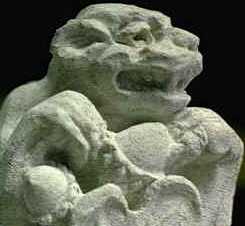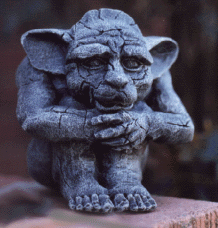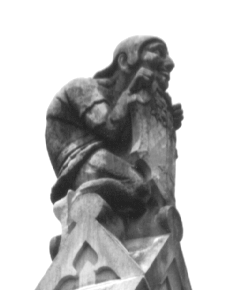Gargoyles are mythological beings. They adorn countless cathedrals around the world. Early references date back to 600 A.D.
The word 'gargoyles' is derived from an old French word gargouille, meaning throat. The English words gargle, gurgle and gargoyle are derived from gargouille.
Some believe that gargoyles - sometimes called grotesques - are inspired by the skeletal remains of prehistoric dinosaurs and other fossils.
Originally a gargoyle was considered a waterspout, directing water away from a building. Technically an architect calls a waterspout on a building a gargoyle. If a stone carving does not carry water and has a face that resembles a creature, it is technically called a grotesque.

Many people believe that gargoyles were created by medieval architects and stone carvers to ward off evil in an imperfect world.
France has over 100 cathedrals, most built in the middle ages, with Notre Dame being the most famous. Churches used awesome
visual images to spread the scriptures, which included gargoyles, stained glass, and sculpture. Some believe that gargoyles were
inspired directly via a passage in the bible. Others believe that gargoyles and grotesques do not come from the bible, but are
inspired by the skeletal remains of prehistoric beasts such as dinosaurs and giant reptiles.
Some people feel that gargoyles are the expression of man's subconscious fears or, that they may be vestiges of paganism from
an age when god would be heard in trees and river plains.
Churches of Europe carried them further into time; maybe to remind the masses that "even if god is at hand, evil is never far away - possibly to act as guardians of their church to keep the terrible spirits of evil away."
A legend has it that a fierce dragon named La Gargouille lived in the river Seine near Paris. The fierce dragon devoured ships and men. The village was saved by St. Romanis, proving the might of Christianity. After the battle, the creature was set ablaze. Its body was destroyed but its head and neck survived which was mounted on a building. This practice spread and La Gargouille perhaps creating the model for the gargoyles we see today.

Many gargoyles are similar to the legends and figures of the ancients Celts, such as the Green Man or Jack of the Green - the god of tree worship. Artists who carved these were inspired by their culture.
Gargoyles can be dragons, men, cats, bats, frogs, serpents, and countless others.
Gargoyles are still being carved today, many with a modern theme such as a whimsical figure pointing a camera down below.
Reference: Encyclopedia Britannica
Gargoyle Wikipedia
Gargoyles are mostly grotesque figures. Statues representing gargoyle-like creatures are popular sales items, particularly in goth and New Age retail stores.
A similar type of sculpture that does not work as a waterspout and serves only an ornamental or artistic function is called a chimera, although these are popularly referred to as gargoyles also.
The term gargoyle is most often applied to medieval work, but throughout all ages some means of throwing the water off roofs, when not conveyed in gutters, was adopted.
In Egypt gargoyles ejected the water used in the washing of the sacred vessels which seems to have been done on the flat roofs of the temples. In Greek temples, the water from roofs passed through the mouths of lions whose heads were carved or modelled in the marble or terra cotta cymatium of the cornice. At Pompeii many terra cotta gargoyles were found that are modelled in the shape of animals.
A local legend that sprang up around the name of St. Romanus ("Romain") (631 641 A.D.), the former chancellor of the Merovingian king Clotaire II who was made bishop of Rouen, relates how he delivered the country around Rouen from a monster called Gargouille, having had the creature captured by a liberated prisoner. The gargoyle's grotesque form was said to scare off evil spirits so they were used for protection. In commemoration of St. Romain the Archbishops of Rouen were granted the right to set a prisoner free on the day that the reliquary of the saint was carried in procession.
Gargoyles, or more precisely chimerae, were used as decoration on 19th and early 20th century buildings in cities such as New York (where the Chrysler Building's stainless steel gargoyles are celebrated), and Chicago. Gargoyles can be found on many churches and buildings.

Submit News/Videos/Links |
Discuss article |
Article Link
|
More unsolved mysteries on Unexplained Mysteries
|




![]()